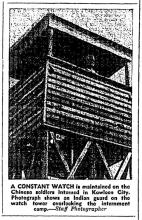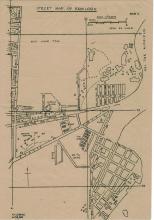As we've just added a place for the Argyle Street camp, here's one for the Ma Tau Chung (also spelled Chong) camp, which was just across the road.
Again, Tony Banham's books and website are the best reference on the subject. On the website he writes:
In January [1942], the camps were rationalised. [...] Ma Tau Chong was opened as the British Indian Army Camp, and ‘enemy’ civilians were sent to Stanley Internment Camp. Other civilian internment camps were opened at Rosary Hill and, later, Ma Tau-wai (which was the renamed Ma Tau Chung, after the remaining Indian POWs were finally moved from there to Argle Street late in the war).
The Ma Tau Wai (also spelled Wei) camp is interesting because our friend Mr Gingle was interned there towards the end of the occupation. On pg 178 of 'We Shall Suffer There', is a note from a Consuelo Delgado y Perez, describing his mother's memories. She was interned at Ma Tau Wai, and "remembers an American cook ('Mr. Jingle')." He had previously been released from Stanley internment camp, but was obviously rounded up and re-interned at some later date.
I guess the site was a British army barracks before the war. Can anyone confirm? It was built as a camp for refugees, see the comments below.



Comments
Re: Ma Tau Chung Camp
Source: HKGRO 1938 PWD Annual Report
Pre WWII, the Ma Tau Chung Camp completed in 1938 was used to accommodate destitute refugees from the war zone in China. Later, the northern portion of the camp was used to accommodate interned Chinese soldiers and additional fencing and watch towers were erected. Other refugee camps at King's Park and North Point were also completed in 1938.
Very interesting about
Very interesting about Gingles.
William Shea, given evidence in a collaboration trial, said that on two occasions he took money 'to 'Gingle's' in Kowloon' at the request of the pre-war jockey Victor Needa. (China Mail, September 18, 1946, page 4). It's not absolutely clear what the money was for: on the one hand, Shea states he wasn't acting in his business capacity (he was working with or for Needa), on the other, he says he doesn't know anything about Needa's claims to have helped people financially. Perhaps some general relief work?
In any case, Gingles was lucky: being an Allied citizen (or even a 'third national') out of a camp in 1943/44 was distinctly dangerous - both Shea and Needa, for example, ended up in prison accused of possessing an illegal radio. I wonder why he didn't go home in June 1942 - he wanted to look after his business interests perhaps?
Ma Tau-wai was where Dr. Selwyn-Clarke was sent when he was amnestied from prison on December 8, 1944 - his wife Hilda and daughter Mary were transferred there from Stanley two days before. Selwyn-Clarke was responsible for the medical side of the Camp.
Arthur May was interned here
Arthur May was interned here on August 12, 1944. He gives a different picture of the set-up to other sources, claiming that he was in Ma Tau-chung and that Ma Tau-wai was separated from this camp by a narrow sentry path. The latter was also a camp, and contained Indian soldiers who had been freed to act as watchmen and carry out minor policing duties but were re-arrested when the fighting started to approach Hong Kong, presumably so they couldn't help the Allies in the event of an attack (Arthur May Papers, University of Hong Kong Library, A-2 and A-24).
He describes a number of visits to the Indian camp (he crawled underneath the wire that confined him) and claims that he'd arranged for a troop of unarmed Indians to leave their camp and join him at the Peak flag raising ceremony on August 18 - he says that he and his fellow engineer J. C. Brown raised the flag at 9 a.m. and the Indian party showed up, as agreed, at 10 a.m., acting in as non-provocative a way as possible.
In other words, his version is backed up by a lot of circumstantial detail.
However, other accounts seem to support Tony Banham's picture: Ma Tau-chung was used for Indian POWs until June 1944 when they were sent to Argyle Street and soon thereafter the camp, renamed Ma Tau-wai, was used to house civilians of different ethnicities - Selwyn-Clarke, who led the camp after December 8, 1944 claims that the majority were Chinese born in South America.
I'm wondering though if, leaving aside the question of names, there's any other evidence of a camp for re-arrested Indian soldiers in that part of Argyle Street in 1944/45?
Some support for May's naming
Some support for May's naming (and a rare description of the camp itself) can be found in a Red Cross report by Rudolf Zindel who visited what he calls Natauchung (sic) on December 22, 1944.
He also visited Stanley, and he seems to have considered them as the two sections of what was now 'the Military Camp' (Stanley was renamed the Military Internment Camp when it came under army control in 1944).
He says that there were 124 people of different nationalities there, 40 men, 40 women and 44 children. It consists of the hospital of the former refugee camp, and 21 buildings, thirteen of which are wooden houses/sheds/barracks ('baraques de bois') each of which has four well-lit and aired rooms which act as the living quarters. The remaining buildings serve as infirmary, offices, camp stores and church (wherein a school for 33 children has been organised). There were vegetable gardens, poultry and a library. The health of the internees was good and the internees were satisfied with their living conditions. (Revue Internationals de Croix Rouge, 1945, 99-100).
Zindel was more or less forced to paint a rosy picture of anything he visited, but even allowing for that, the camp seems to have been a good one.
Completion of Ma Tau Chung Refugee & Internment Camp
Ma Tau Chung Refugee Camp was completed on 1 December 1938. The Camp took less than 2 months to complete and provided accommodation for 2,016 persons.
The northern portion of the camp was later used as an internment camp for Chinese soldiers. Additional fencing was erected together with watch towers, latrines, kitchen and quarters for guards.
Source: Report of the Director of Public Works for the year 1938